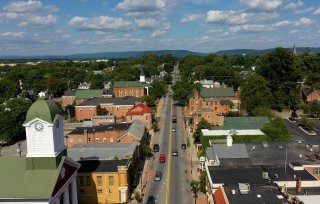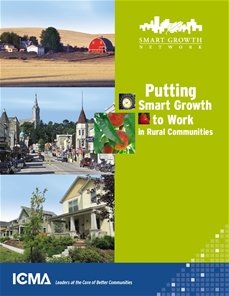Smart Growth in Small Towns and Rural Communities
Background

The issues experienced by small towns and rural communities are multiple, ever-changing, and unique to their place. Slow-growing and shrinking rural areas might find that their policies are not bringing the prosperity they seek. Fast-growing rural areas are facing increasing development pressures and resultant challenges, such as housing affordability and traffic congestion. In addition, many rural areas are struggling with the loss of farmland and working lands, job and labor shortages, or other workforce development issues.
Many rural communities are also increasingly facing the impacts of climate change, with many having experienced and/or recovering from weather-related disasters. To foster greater resilience, small towns and rural communities are identifying ways to strengthen their built environment and economies, provide better a quality of life for residents, and enhance local assets.
Through its work in partnership with small towns and rural communities, EPA has identified several smart growth strategies for these types of communities to consider:
- Planning where development should or should not go can help a rural community encourage growth in town, where businesses can thrive on a walkable main street and families can live close to their daily destinations.
- Encouraging policies that support walking, biking, and public transit can help reduce air pollution from vehicles while saving people money.
- Encouraging policies that protect the rural landscape can help preserve open space, protect air and water quality, provide places for recreation, and create tourist attractions that bring investments into the local economy.
A comprehensive approach to planning for growth or managing decline can support a cohesive, community-centered framework for meeting the current and evolving needs of small towns and rural communities. Tools such as zoning codes, local economic development, climate resilience planning, and community engagement are key elements that form the foundation of sustainable and equitable growth and revitalization.
OCR Technical Assistance
EPA's Office of Community Revitalization offers technical assistance to help all types of communities, including rural places, learn about and implement inclusive planning and development approaches that promote revitalization and smart growth.
- Building Blocks for Sustainable Communities: This program helps communities design and implement smart growth approaches on a range of topics, including equitable development and sustainable development for rural communities.
- Local Foods, Local Places: This partnership between EPA, the Appalachian Regional Commission, and USDA helps communities create more livable places by promoting local food enterprises such as farmers’ markets, food hubs, community gardens, and community kitchens on main streets in downtowns and existing neighborhoods.
- Recreation Economy for Rural Communities: This initiative from EPA, the U.S. Forest Service, the Northern Border Regional Commission, and the Appalachian Regional Commission offers planning assistance to help communities develop strategies and an action plan to revitalize their Main Streets through outdoor recreation.
Additional Resources
Case Studies
- Cool & Connected: Nine Actions for Success (2020): This page highlights specific actions small towns could take to use broadband to revitalize downtowns, create economic opportunities, and protect the environment.
- Gloucester, Massachusetts (2017): This coastal town leveraged Local Foods, Local Places planning assistance to strategize about how to improve its waterfront area and cultivate local support for the city's seafood industry.
- Madison County, New York (2015): This community was a pilot for the Smart Growth Self-Assessment for Rural Communities tool that can help communities evaluate their policies, programs, and codes.
- How Small Towns and Cities Can Use Local Assets to Rebuild Their Economies: Lessons From Successful Places (2015): This report includes case studies of small towns and cities that emphasized their existing assets and distinctive resources to build their economies.
Publications
Visit our Publications page for a full list of publications about rural smart growth.
- EPA's Perspective Blog (2023): Read the inspiring view of the RERC program manager in "How Community-Led Change is Helping Rural Places and People Thrive."
- Framework for Creating a Smart Growth Economic Development Strategy: A Tool for Small Cities and Towns (2016): Step-by-step guide to building a place-based economic development strategy. It is intended for small and mid-sized cities, particularly those that have limited population growth, areas of disinvestment, and/or a struggling economy.
-

Essential Smart Growth Fixes for Rural Planning, Zoning, and Development Codes (2012): Provides policy options that can help rural communities strengthen their economies while preserving rural character. Topics include fiscal impact analysis, commercial development, wastewater infrastructure, rural roads, and efficient development patterns.
- Putting Smart Growth to Work in Rural Communities (2010): Focuses on smart growth strategies to meet three main goals: support the rural landscape by keeping working lands viable and conserving natural lands; help existing places thrive by taking care of investments and assets; and create great new places by building lively and enduring neighborhoods where people want to live.
